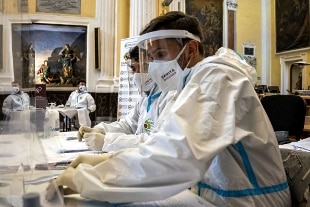Gimbe: less infections with "Christmas Decree".
Vaccines: supplies chaos, second dose at risk
Share
January 28, 2021The slow descent of the curves continues.
Collapse of supplies in the first quarter for vaccines, regional inequalities on all fronts.
The Gimbe Foundation notes this in the monitoring for the week 20-26 January in which the last effects of the Christmas decree are recorded: all numbers are decreasing, including hospital ones, even if hospitalizations and intensive care remain above the saturation threshold in 5 and 6 regions respectively.
Gimbe's independent analyzes of the official data of the vaccination campaign highlight significant regional differences: in the distribution of doses, in the completion of the vaccination cycle and, above all, in the priority of administration, with 22.3% of the doses intended for "non-healthcare personnel" , a category not formally provided for in the vaccination plan.
The Gimbe Foundation notes that in the week 20-26 January 2021, compared to the previous one, there was a reduction in new cases (85,358 vs 97,335).
Currently positive cases are also decreasing (482,417 vs 535,524), hospitalizations with symptoms (21,355 vs 22,699) and intensive care (2,372 vs 2,487);
slight decrease in deaths (3,265 vs 3,338).
The percentage increase in cases is reduced in almost all the Regions;
in hospitals, despite the further decline in hospitalizations and intensive care, employment by Covid patients continues to exceed the threshold of 40% in the medical area in 5 regions and in 6 regions that of 30% in intensive care units, reaching national level at 34% and 28% respectively.
"In addition to Pfizer's known delivery delays - says Renata Gili, Head of Gimbe Research on Health Services of the Foundation - AstraZeneca has communicated to the European Commission an estimated supply reduction of up to 60% in the first quarter, while CureVac will not be able to deliver within March the 2.019 million doses foreseen by the vaccination plan, given that the phase 3 study was only started on December 14th ".
Consequently, net of delivery delays, Italy should have 16.557 million doses by 31 March 2021, of which 8.749 million from Pfizer-BioNTech and 1.346 million from Moderna and 6.462 million from AstraZeneca, instead of the 16.155 million expected. from the vaccination plan.
Moreover, the accounts do not add up on AstraZeneca as a supply of 3.4 million doses has been announced.
"With this availability - points out Cartabellotta - only 14% of the population (about 8,278 million people) will be able to complete the two doses of the vaccination cycle, but not before the middle or even the end of April, obviously with the conditional authorization of the AstraZeneca vaccine. which could be subject to limitations for subjects over the age of 55 with the consequent need to review the priorities of the vaccination plan. Furthermore, a considerable reactivity of the organizational machine will be required, given that most of the doses will not arrive before mid-February " .
On the regional distribution of vaccines, the Gimbe Foundation underlines that there are significant regional differences that are difficult to explain only on the basis of the criteria used in this first phase for delivery (n health and social-health workers, n staff and RSA guests).

